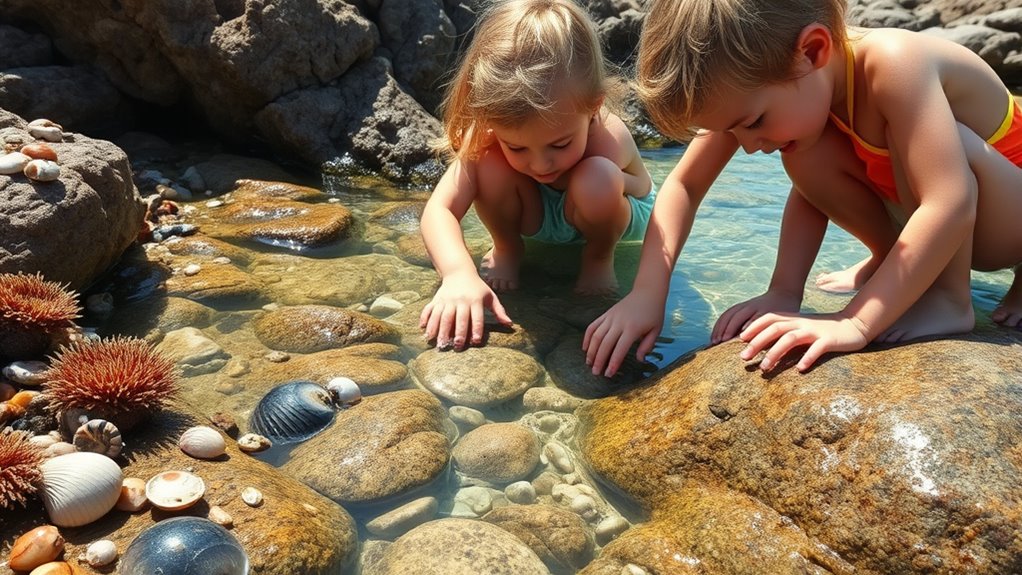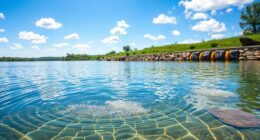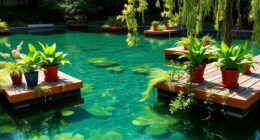To create a fun DIY tide pool exploration with kids, plan your trip around low tide using local tide charts. Pick accessible, safe locations with gentle waves and interesting marine life. Equip everyone with waterproof shoes, magnifying glasses, and small buckets for collecting shells. Encourage respectful observation and gentle interaction with wildlife. If you want to discover more tips and activities to make your adventure memorable, continue exploring these helpful ideas.
Key Takeaways
- Research tide charts to plan visits during low tide for safe and accessible tide pool exploration with kids.
- Prepare appropriate gear, including waterproof shoes, magnifying glasses, and buckets for collecting shells and marine creatures.
- Choose safe, accessible tide pool sites with minimal hazards, and visit during calm weather conditions.
- Teach kids respectful observation by maintaining distance from wildlife and avoiding disturbance to habitats.
- Incorporate fun activities like scavenger hunts, drawing, or simple experiments to enhance learning and engagement during the exploration.
Planning Your Tide Pool Adventure
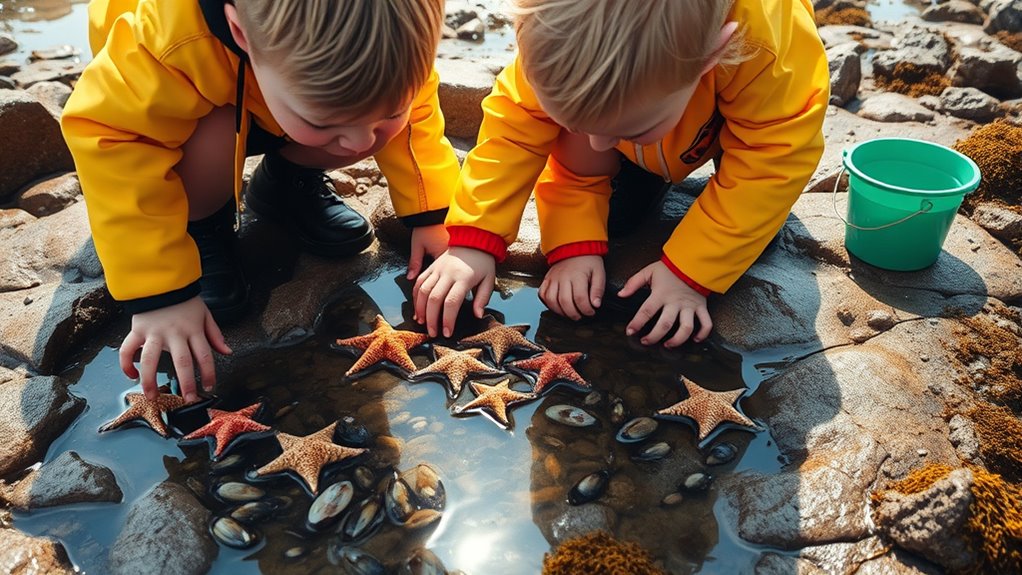
Before heading out to explore tide pools, planning your trip carefully is vital. Start by researching the best tide times, usually during low tide, when pools are more accessible and full of life. Check local tide charts to pick the right day and time. Scout your location ahead of time to identify safe, accessible spots with minimal waves. Consider the weather forecast—avoid days with heavy rain or storm warnings. Map out your route, including nearby parking or public transit options, and note the distance from your vehicle to the tide pools. Prepare a checklist of essentials, and let someone know your plans. Proper preparation ensures your adventure is safe, enjoyable, and stress-free, giving you more time to discover the fascinating creatures hiding in the tide pools.
Essential Gear for Young Explorers
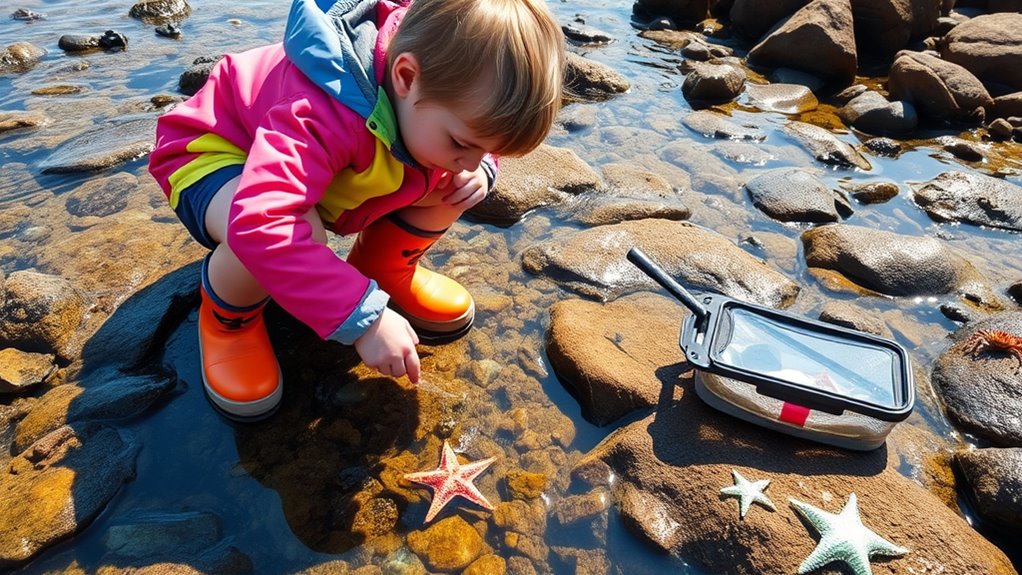
Having the right gear is key to making your tide pool exploration safe and fun for young adventurers. Essential items include a sturdy bucket, a small net, and waterproof shoes to protect little feet. A magnifying glass helps kids observe tiny creatures up close, while a towel keeps everyone dry and comfortable. To keep things organized, pack a lightweight backpack with these essentials. Here’s a quick overview:
| Gear Item | Purpose |
|---|---|
| Sturdy Bucket | Collects shells and creatures |
| Small Net | Catching and observing marine life |
| Waterproof Shoes | Protects feet from sharp objects |
| Magnifying Glass | Enhances close-up viewing |
This gear guarantees safety and curiosity, making your tide pool adventure memorable. Proper environmental awareness ensures that young explorers respect the marine ecosystem while enjoying their adventure, and understanding marine biodiversity helps them appreciate the variety of life they may encounter. Developing a sense of marine conservation early on fosters responsible behaviors that protect these delicate habitats. Additionally, teaching children about interdependence within ecosystems can deepen their appreciation for nature’s balance. Learning about species identification can help children recognize different marine animals and plants, enriching their experience and understanding of the ecosystem.
Choosing the Best Tide Pool Locations

To find the best tide pools, start by choosing spots with safe access that won’t put you at risk. Pay attention to the timing of the tides, as low or mid-tide offers the safest and most interesting exploration. Planning your visit during the right tide guarantees you see the most marine life and avoid dangerous currents. Additionally, researching local camping locations can help you identify nearby spots with suitable access points for tide pooling excursions. Understanding industry trends can also provide insights into the most popular and reliable tide pooling destinations in your area. Considering self watering plant pots in nearby gardens or coastal plant displays can offer inspiration for sustainable and low-maintenance plant care during your trip planning. Incorporating modern farmhouse decor trends can inspire a cozy, rustic atmosphere for your outdoor setup, blending functionality with aesthetic appeal. Being aware of state tax implications for IRA withdrawals can help you plan financially for your trip, ensuring you maximize your savings and minimize taxes while enjoying your outdoor adventures.
Safe Access Tips
Choosing the right tide pools to explore is essential for a safe and enjoyable experience. To guarantee safe access, plan your visit during low tide and check tide charts ahead of time. Always wear sturdy shoes to navigate rocky terrain confidently. Look for tide pools that are easily accessible without climbing or jumping, and avoid areas with slippery rocks or strong currents. Use a walking stick for extra stability on uneven surfaces. Keep an eye on the weather, avoiding visits during storms or rough seas. Remember to respect the environment by staying on established paths and not disturbing marine life. Additionally, understanding marine ecosystems can enhance your appreciation and help you identify various marine species responsibly. Being aware of marine biodiversity can also improve your ability to recognize different creatures during your exploration. Familiarizing yourself with tidal patterns can help you plan your visit for optimal safety and viewing opportunities. Recognizing marine habitats can guide you to the most interesting and safe areas to explore. Learning about marine conservation is crucial for protecting these delicate environments for future generations. With careful planning and awareness, you can safely enjoy discovering the fascinating creatures hidden in tide pools.
Best Tides to Visit
The best time to visit tide pools is during low tide when more of the rocky shoreline is exposed, revealing rich marine life. Check local tide charts to plan your visit around the lowest tides, usually occurring twice a day. Early mornings or late afternoons often offer the most dramatic tide changes, providing ample exploration time. Avoid rushing during high tide, as many creatures retreat into hiding. Look for spots known for diverse marine life, such as rocky outcroppings, sandy coves, or tide pools near jetties. Visiting during these ideal times ensures you and your kids can see sea stars, anemones, crabs, and other fascinating creatures up close. Planning ahead guarantees a safe, educational, and exciting tide pool adventure.
Safety Tips for Tide Pool Exploration
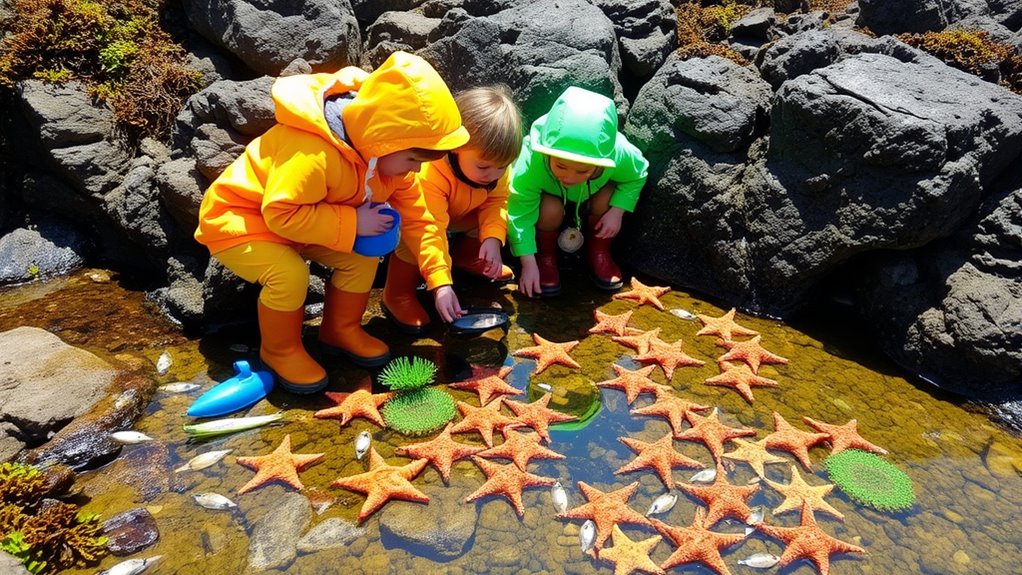
When exploring tide pools, make sure you wear proper footwear to protect your feet from sharp rocks and creatures. Respect wildlife boundaries by observing animals without disturbing them or their habitats. Always stay aware of tides and weather conditions to stay safe and avoid getting stranded or caught off guard. Using a trash-free approach can help preserve the natural beauty and health of the tide pool environment. Additionally, being aware of maintenance and filter replacement guidelines can inspire sustainable practices even in outdoor activities. Proper noise levels in nearby areas help ensure that your activities do not disturb local wildlife or fellow visitors, contributing to a more respectful environment. Remember that environmental impact plays a crucial role in maintaining healthy tide pool ecosystems for future generations.
Proper Footwear Essential
Wearing the right footwear is essential for safe tide pool exploration. Proper shoes protect your feet from sharp rocks, shells, and slippery surfaces. Choose sturdy, closed-toe shoes that provide good grip and support. Avoid sandals or flip-flops, which offer little protection and can slip easily. Look for footwear with textured soles to prevent slips on wet rocks. Ensure your shoes fit well and stay snug during movement. Consider waterproof shoes or quick-drying options to keep your feet dry and comfortable. Proper footwear not only enhances safety but also lets you explore more confidently. Remember, a good pair of shoes can make your tide pooling adventure enjoyable and injury-free. Prioritize your safety with footwear that’s suited for the unpredictable coastal terrain. Using appropriate footwear can significantly reduce the risk of slips and injuries in rugged environments. Additionally, choosing footwear with traction-enhancing soles can further improve your stability on uneven surfaces. Investing in durable, supportive shoes can also help prevent foot fatigue during extended exploring sessions. Selecting footwear with water-resistant materials ensures your shoes stay dry longer, increasing comfort during your exploration. Moreover, selecting shoes with adequate ankle support can help prevent sprains and provide extra stability on uneven terrain.
Respect Wildlife Boundaries
To guarantee both your safety and the well-being of tide pool ecosystems, it’s important to respect wildlife boundaries during your exploration. Always observe animals from a distance and avoid touching or disturbing them. Remember, tide pools are their homes, so give creatures space to thrive. If you see an animal hiding or retreating, don’t try to coax it out or move it. Use gentle, slow movements if you need to get a closer look, and never pick up or remove animals or shells. Keep your hands to yourself and encourage kids to do the same. Respectful behavior ensures the tide pools stay healthy and vibrant for future visits—and keeps everyone safe during your adventure.
Tides and Weather Awareness
Being aware of tides and weather conditions is essential before exploring tide pools, as these factors directly impact your safety and the health of the ecosystems. Always check local tide charts to understand when low tide occurs, ensuring safe access and observation. Keep an eye on weather forecasts; strong winds or storms can create dangerous wave action and slippery surfaces. Sudden changes in weather can catch you off guard, so be prepared with appropriate clothing and gear. Understanding style and appearance options can also help you dress appropriately for outdoor conditions.
Observing Marine Life Carefully

When exploring tide pools, paying close attention to marine life reveals fascinating details that might otherwise go unnoticed. Observe how sea stars grip surfaces with their tube feet or how crabs scuttle sideways, hiding in crevices. Look at the colors and patterns on sea anemones and the tiny movements of barnacles. Use your eyes and a magnifying glass if you have one to spot small creatures like tiny shrimp or worms. Notice textures—smooth shells, rough coral, or sticky tentacles. Take your time, and don’t rush. Watching carefully helps you understand how these animals live and interact. By focusing on the details, you turn a simple tide pool visit into a engaging discovery of the ocean’s hidden world.
Engaging Activities to Enhance Learning
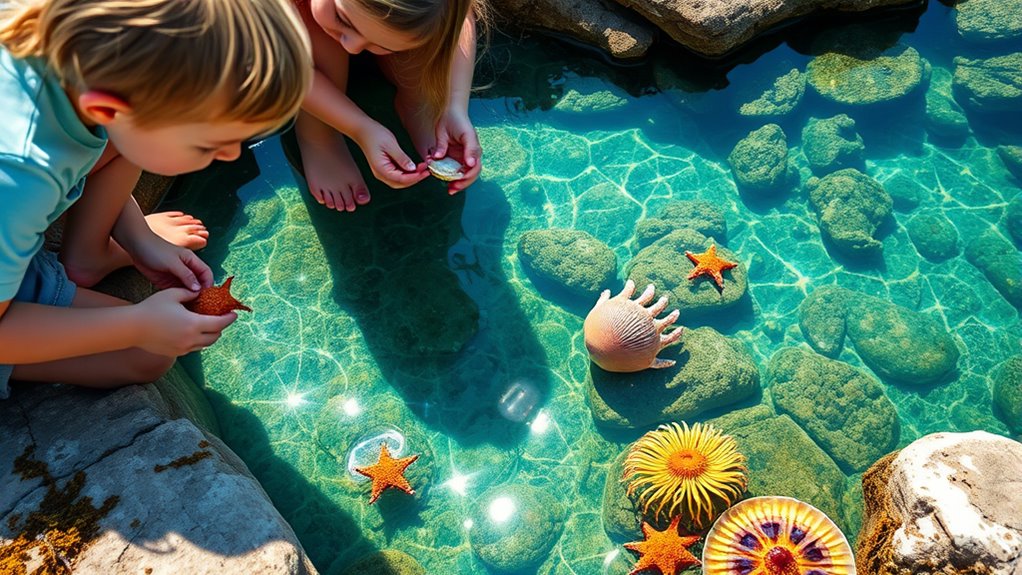
Engaging activities transform a simple tide pool visit into an interactive learning experience. You can encourage curiosity and deepen understanding by incorporating fun, hands-on tasks. For example, challenge kids to identify different species using a guidebook or smartphone app. You might also organize a scavenger hunt for specific creatures or shells, fostering observation skills. Another idea is to have them draw or photograph their discoveries, helping with memory and documentation. Additionally, you can facilitate simple experiments, like testing water temperature or salinity, to connect science concepts to real-world observations. These activities make the exploration more meaningful, inspiring kids to ask questions and stay interested in marine life. Keep activities engaging, educational, and suited to their age to maximize learning during your tide pool adventure.
Respectful Interaction With Nature
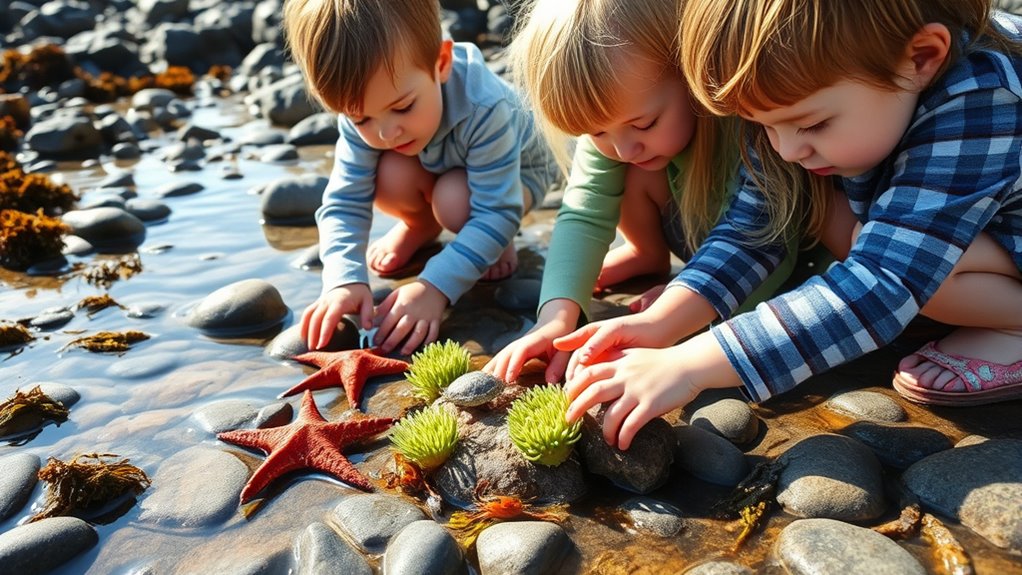
To truly enjoy tide pool exploration, you need to interact with the environment respectfully. Always observe wildlife without disturbing it. Move slowly and avoid making loud noises that could scare creatures away. When touching or handling marine life, do so gently and sparingly; many animals are delicate and can be harmed easily. Stick to staying on rocks and avoid removing shells or organisms unless you’re certain it’s okay and within local regulations. Remember, tide pools are fragile ecosystems; your goal is to appreciate their beauty without causing harm. By being mindful and respectful, you help preserve these vibrant habitats for future explorers and maintain the balance of nature you’re lucky enough to witness.
Post-Exploration Cleanup and Reflection

After your tide pool adventure, it’s important to leave the environment just as you found it. Make sure you clean up any trash or equipment you brought, taking care not to disturb the surroundings further. Encourage kids to gently rinse their hands and gear to remove sand and salt. Reflect on the experience by discussing what you saw, learned, and enjoyed. This helps kids appreciate the importance of respecting nature and fosters curiosity. Consider taking photos or drawing sketches to remember these moments. Remember to:
- Pack out all trash and belongings
- Wipe down equipment and hands
- Talk about favorite discoveries or surprises
- Plan your next exploration or activity
This reflection solidifies the experience while ensuring the site remains pristine for others.
Tips for Making the Experience Memorable

Creating lasting memories during your tide pool adventure can be simple and fun. Start by encouraging curiosity—ask your kids questions about what they see and let them lead the exploration. Bring a camera or sketchpad to capture their favorite creatures and moments. Make it special by packing a picnic or snacks to enjoy nearby, turning the outing into a relaxed, enjoyable experience. Share stories about the marine life you encounter, and teach kids fun facts to deepen their interest. Use a hands-on approach, letting kids touch and observe the creatures carefully. Celebrate their discoveries with praise and excitement. These small touches turn a simple tide pooling trip into an unforgettable adventure that sparks curiosity and creates meaningful memories.
Frequently Asked Questions
What Should I Do if I Encounter a Stranded or Injured Marine Animal?
If you encounter a stranded or injured marine animal, stay calm and keep a safe distance to avoid further stress. Gently contact local wildlife rescue or marine animal rescue organizations immediately. Provide them with details about the animal’s location and condition. Do not attempt to feed or handle the animal yourself, as this could cause more harm. Your quick action helps guarantee the animal receives proper care and increases its chances of recovery.
Are There Specific Tide Schedules That Are Best for Exploring?
Imagine planning your tide pool visit during low tide, when the water recedes and reveals more creatures. Generally, exploring during low tide is best because the tide schedule exposes more of the shoreline and marine life. To find the ideal times, check local tide charts or apps. This way, you guarantee a safer, more educational experience, and you get to observe a diverse array of marine animals up close.
How Can I Identify Different Species of Marine Life Safely?
To identify different marine species safely, start by bringing a guidebook or using a trusted app with pictures and descriptions. Observe their size, shape, color, and behaviors carefully without touching or disturbing them. Move slowly and avoid sudden movements to prevent startling the creatures. If you’re unsure, keep a safe distance and ask an expert or local marine authority for help. Remember to respect wildlife and protect their habitat.
What Are the Signs of Dangerous Marine Creatures to Watch Out For?
Did you know that over 200 marine species are venomous, making it essential to recognize dangerous creatures? When exploring tide pools, watch for bright colors, unusual shapes, or sudden movements—they often signal a threat. Avoid handling unfamiliar animals, especially if they have spines, stingers, or slimy textures. If you see a creature acting aggressively or hiding, keep your distance to stay safe and protect the delicate ecosystem.
How Can I Teach Kids About Marine Conservation During the Trip?
You can teach kids about marine conservation by explaining the importance of protecting ocean life and ecosystems. Encourage them to observe without disturbing creatures, pick up trash, and be mindful of their impact. Share fun facts about marine animals and how everyone can help preserve their habitats. Use simple language and real-life examples to inspire respect and responsibility for the ocean, making conservation meaningful and memorable during your trip.
Conclusion
Your tide pool adventure is like opening a treasure chest of discoveries. With the right planning, gear, and respect for nature, you’ll create unforgettable memories for your kids. Every peek into the vibrant marine world is a chance to learn and connect. So, plunge in with curiosity and care, turning this outing into a magical journey that nurtures both wonder and responsibility. Get ready to make waves in your family’s outdoor adventures!

